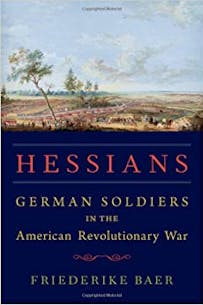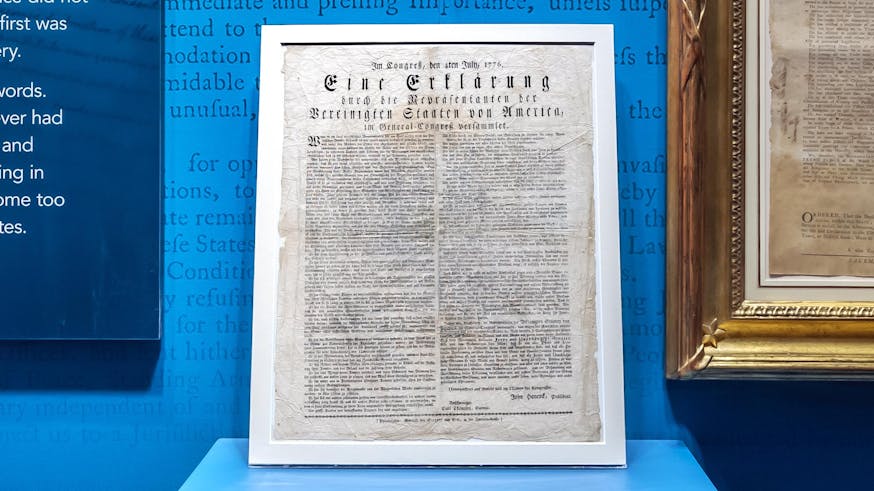Read the Revolution
Hessians
May 11, 2022
Purchase the book from Oxford University Press.
What was the Revolutionary War like for the German soldiers who fought alongside the British? Between 1776 and 1783, Britain hired an estimated 30,000 German soldiers to fight in its war against the American rebels. These soldiers traveled along with accompanying civilians, including hundreds of women and children. The German military units actively recruited Black men as musicians, laborers, servants and, in rare instances, privates. When the British evacuated the United States in 1783, an estimated 200 Black men, women, and children went with the German corps to Germany.
In her new book, Hessians: German Soldiers in the American Revolutionary War, historian Dr. Friederike Baer offers a groundbreaking reimagining of Britain’s war against American independence from the perspective of German soldiers. Although this group has been collectively known as “Hessians” for centuries, Baer begins with an argument for a more nuanced view of this term:
"Britain concluded subsidy treaties for the hire of soldiers with six German territories within the Holy Roman Empire: Hessen-Kassel, Hessen-Hanau, Braunschweig-Wolfenbüttel, Anhalt-Zerbst, Ansbach-Bayreuth, and Waldeck. Because the majority of soldiers were supplied by the territories of Hessen-Kassel and Hessen-Hanau, the label “Hessian” has been used since the 1770s to describe all German troops in British service in North America, regardless of place of origin. For this reason, I am using the term in the title of this book. However, in the narrative, I will use “German” when referring to the troops collectively, and “Hessian” when discussing Hessian units or individuals belonging to the Hessian corps. After all, the subsidy troops and affiliated civilians never described themselves as Hessians unless they were actually from Hessen or belonged to a Hessian military unit. More important, lumping all German troops together as “Hessians” reinforces a simplistic and one-dimensional image of what in reality was a complex and diverse group of people. The depiction of the German troops as a monolithic body without individuality coupled with the tendency to deny them agency — they were mercenaries who followed orders without question — serves to minimize and marginalize their participation in the war. The tendency to discount their role amounts to a missed opportunity to create a fuller and more nuanced narrative of the American Revolutionary War. The German troops were not mindless pawns of Britain’s king."
Read an excerpt about the large volume of private and official German records that Baer translated for this book, and continue for an additional excerpt from Chapter 9: “Good Night, Peace” Philadelphia, 1777 to learn how German soldiers and German American culture intersected in Germantown during the British occupation of Philadelphia in 1777-1778.
Excerpt 1
How did the thousands of German auxiliaries who went to North America experience and describe the war they fought in, the land they traversed, and the people they encountered? This book’s main objective is to answer these questions. By focusing on the Germans’ experiences, it moves beyond the themes and geographic regions that have traditionally been emphasized in narratives of the Revolutionary War. For example, a focus on German authored accounts necessarily pulls in geographic regions that tend to be treated as peripheral to the war, including Canada and West Florida. In fact, the Germans did not distinguish between rebel and loyal provinces, all of which were sites of military encounters and profoundly affected by the war. In addition, they describe the war in most regions as exceptionally challenging. This was mostly due to the terrain and climate and the largely unfamiliar style of warfare they experienced in North America. An inability to distinguish between friend and foe presented additional challenges. There were also the language barrier and the perception of certain allies, including Loyalists and Native Americans, as suspect, if not outright dangerous. Based on German-authored accounts, it was an unusually brutal conflict, with local populations subjected to violence perpetrated by all sides, including the Americans. Over the course of the war, they also became increasingly frustrated with British military strategy. From their perspective, there was more than one missed opportunity when the war could have been concluded in their favor. The outcome of the conflict was by no means preordained.
Moreover, considering the destruction of property and violence against locals they saw throughout the land, the Germans were deeply suspicious of American civilian and military leaders’ true intentions. Initial impressions of the land, especially of the region around New York, were universally positive. The Germans were amazed by the evident wealth and a standard of living that struck them as significantly higher than what they knew in Germany. In general, they could not fathom why the Americans would rise up against a king under whose reign they had grown remarkably prosperous. The rebellion, they concluded, could not possibly be in the interest of the people. In addition, the Germans were universally appalled by the institution of slavery and the manner in which white Americans treated enslaved people. They believed that the benefits of America’s wealth were reaped by white people at the expense of others, especially Black men, women, and children.
The Americans had a somewhat paradoxical view of the German auxiliaries. On the one hand, they depicted them as ruthless mercenaries paid to do the dirty work of the king. On the other hand, they saw them as the innocent victims of tyrannical rulers who had been pressed to go to war against a people that had done them no harm. The view of the Germans as unwilling participants in the conflict helps explain why the Americans actively encouraged them to desert their colors and settle in America. The thousands of Germans that were captured by the Americans over the course of the war were ideal targets for their propaganda and, beginning in the early 1780s, even recruiting efforts. Ultimately, however, the vast majority of the Germans who survived the war returned to Europe. Some Americans seized the opportunity to leave the United States with them. Among them were at least 200 Black men, women, and children who eventually settled in Germany.
An examination of German-authored records, including in particular diaries and letters, thus draws the eye from an abstract view of the war to more personal, subjective narratives of this period in American history. It provides us with a more differentiated picture of the Germans’ experiences and perceptions, which, in turn, broadens our understanding of American society during the Revolutionary War. Their vantage point is unlike that of any other group of people that participated in the war. In this book, I have tried to let them tell their stories. This, then, is a study of Britain’s war against the American rebels from the perspective of the German auxiliary troops, a people uniquely positioned both in the midst of the war and at its margins.
Sign Up!
Get biweekly Read the Revolution featured excerpts right to your inbox.
Excerpt 2
The German soldiers were no less suspicious of the people who lived in the city and Pennsylvania’s countryside. At the time of the Revolution, the province was home to around 330,000 individuals, including about 8,000 African Americans. At least one third of the population was German. The province had become an attractive destination for Europeans in search of opportunity thanks largely to an abundance of affordable, fertile land and the promise of religious freedom. The German officers, however, were not impressed...
[...]
Some of the German officers may have thought, perhaps naively, that the Germans inhabitants would view them with at least some degree of sympathy, on the grounds that they shared certain customs and manners, including the language. This was not the case. None of the German-authored accounts of the Philadelphia campaign points to the German inhabitants as particularly friendly. On the contrary, the soldiers and local Germans seemed to have approached each other with a strong sense of suspicion, if not outright hatred. For obvious reasons, German Americans were angry that fellow Germans had joined the war that brought destruction to their country, regardless of their political sentiments. Even Native Americans, the Lutheran pastor Henry Melchior Muhlenberg, who resided in Trappe, roughly thirty miles from Philadelphia, wrote in his diary, were astonished that they had been taken to America to kill otherwise peaceful inhabitants, including women and children, who had done them no harm. On occasion, German Americans directly challenged German soldiers about their motives for participating in the war against the colonists. For example, an elderly German American woman asked [German military officer Johann] Ewald, in German, what harm the Americans had done to the Germans that they would come to America, and whether they would continue in Pennsylvania the “murderous burning” they had done in New York and New Jersey.
[...]
The rank and file may have been less likely to view locals with the degree of condescension exhibited by their superiors, largely because most came from similar socioeconomic backgrounds. However, the German common soldiers who marched through the province as members of the mighty British army would probably also have viewed German American rural folk with a certain degree of disdain. It is safe to say that, in general, the relationship between German soldiers and German Americans was tense, if not openly hostile.
Despite the fact that the German soldiers viewed German Americans with suspicion, they very much appreciated the German character of their communities. In fact, even [the Hessian Captain Andreas] Wiederhold, who had such a low opinion of German Americans, welcomed the availability of beer and food that was prepared in the German manner, and he agreed that their settlements were particularly well developed and maintained. This included towns such as York and Lancaster, where many Germans spent time as captives, as well as Philadelphia and Germantown, the community northwest of the city where Howe’s main army was encamped during its presence in the city. German officers’ impressions of the latter two were particularly favorable, especially in contrast to the rural regions of the province. As Hinrichs put it, “there is no nation living in this good world, embracing such a hodge-podge of civilization and semi-barbarism and where therein is found side by side such learning and stupidity, virtue and vice, shortcomings and accomplishments as are to be found among the Pennsylvanians.”
Germantown had been founded by a handful of German families in 1683. In the 1770s, it essentially consisted of a three-mile-long road that was flanked by a number of large stone buildings. It was small but attractive. Most of the inhabitants spoke German, and there even was a German-language newspaper. From October 1777 to June 1778, the Germantown-based printers Christopher and Peter Saur published the Pennsylvania Staats-Courier, a rabidly Loyalist weekly. German soldiers read it, and they used it like their hometown paper during their stay in the region. One issue from May 1778, for example, included an advertisement by an Ansbach officer in search for a servant with experience in dressing hair. In quaint Germantown, one Hessian officer felt almost “like being back in Germany.”
Overall, the Germans also had a favorable opinion of Philadelphia, the largest city in British North America at the time. As the seat of government, a center of commerce and learning, and home to many prominent Americans, it was a particularly attractive destination for German officers eager to broaden their knowledge of America. Captain Geismar, a member of the Convention Army, reportedly declined an opportunity to leave captivity and return to Europe because he hoped to visit Philadelphia while on parole. To his disappointment, he never made it to the city. Many other German soldiers spent some time there over the course of the war, either as prisoners of war or as members of Howe’s army. The latter enjoyed considerable freedom to explore the many sites they had heard about.
[...]
Of course, the reason for the Germans’ stay in Philadelphia was not to satisfy their curiosity but Howe’s attempt to control and subdue it. Despite the city’s many attractive features, the close to nine months that the army remained there was not a particularly pleasant period for the German soldiers...
[...]
October 1777 turned out to be a bad month for the German troops in North America. News of the occupation of Philadelphia by the British army reached Germany around the same time as the news of Red Bank and Burgoyne’s surrender at Saratoga. The latter events overshadowed everything else that had occurred that year. The German rulers grew increasingly anxious to find out the state of their forces in America. For example, the margrave of Ansbach-Bayreuth, who had not heard anything about the condition of his men since August 1777, was greatly alarmed that the “Misfortune” that happened to Burgoyne could potentially happen to his regiments. The surrender did not bode well for the rest of the British army in America. As the margrave’s minister put it, “the Plan of Operations was too extensive in a Country where the Success of them depends upon so many Incidents.” All of the rulers must have considered the possibility that their subjects might share the fate of the many Braunschweig, Hanau, and Hessian soldiers who had been lost at Trenton, Bennington, Saratoga, and now Red Bank. The prospect of the remaining Germans seemed frightening indeed.
And yet, none of these setbacks and concerns led any of the German rulers to end or at least limit the shipment of additional troops to America. Every year, they continued to send hundreds of fresh recruits across the Atlantic to North America, to make up for the many soldiers lost to disease, accident, battle, desertion, and capture. The rulers may have lamented the loss of their troops, but this did not decrease their eagerness to generate revenue and honor the terms of the subsidy contracts. In fact, they actively pursued opportunities to hire out even more soldiers to Britain. And the British government, more determined than ever to put down the rebellion, was willing to pay for these reinforcements. If anything, its demand for troops only increased as a result of the setbacks in October 1777.
Friederike Baer, Hessians: German Soldiers in the American Revolutionary War (Oxford University Press, 2022), 2-5 and 238-243, 253.
Read the Revolution is sponsored by The Haverford Trust Company.
Read the Revolution is published biweekly by the Museum of the American Revolution to inspire learning about the history of the American Revolution and its ongoing relevance.
Tags
Learn More

Read the Revolution Speaker Series with Friederike Baer
May 12, 2022 from 6:30-8 p.m.
Read the Revolution Speaker Series


